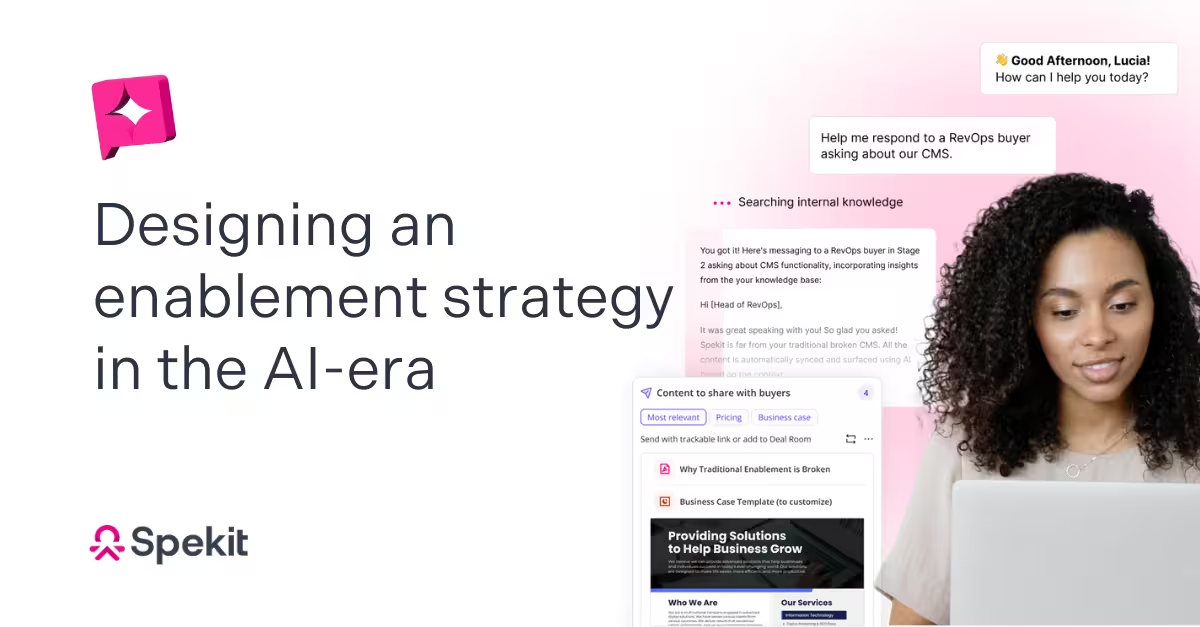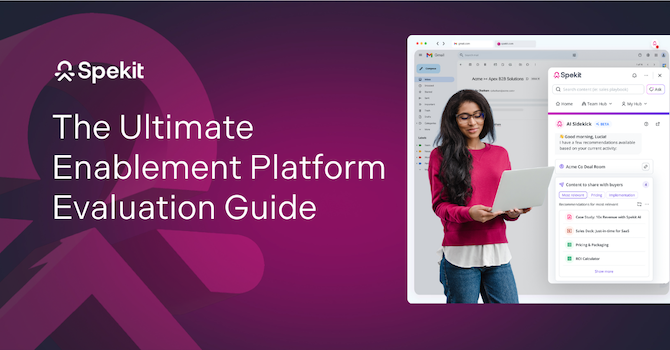Sales moves fast, and it’s easy for enablement to become reactive. You start rolling out assets, onboarding tools, and launching training without a clear plan for how it all connects or drives performance.
It wastes time, resources, and rarely makes the impact on rep performance and revenue that you need it to.Ěý
For sales enablement to be a driver of both, you need to become proactive. And that starts with building a modern sales enablement strategy.
This article will help you build and implement your own sales enablement strategy that delivers measurable results from the assets you create.
We’ll cover:
- What a modern sales enablement strategy is (and isn’t)
- Six sales enablement strategies that have been tested in the real world (and how şÚÁĎłÔąĎÍř helps you implement them)
- A simple, practical framework for building your own enablement strategy
- The tools powering the best sales enablement programs today
‍
What a modern sales enablement strategy actually looks like
A modern sales enablement strategy is a system that equips sales teams with the knowledge, content, and tools they need to perform right inside the platforms they use to sell, like Salesforce, Outlook, LinkedIn, or Slack.
Modern sales enablement strategies are:
- Dynamic: They evolve in real time as products, messaging, and markets change. Content is updated, refined, and redistributed based on what’s working in the field at that moment.
- Personalized: Training and guidance are tailored to each rep’s context, whether that’s their role, pipeline stage, or performance metrics. No two reps sell or learn the same way, and modern enablement accounts for that.‍
- Embedded: Enablement happens inside the tools reps already use, so learning and selling become one continuous motion. Reps don’t step away from their workflow to learn; they learn as they work.
The following six strategies are all facets of this modern approach. They are real-world plays that show what great enablement looks like in action and what can be achieved from them.
6 sales enablement strategies and tactics to learn from (with real-world examples)
The best way to understand what works is to see it in action. Here are six sales enablement strategies top companies are using to drive real results:Â
1. Create a unified, easily accessible content hubÂ
Many sales teams still rely on disjointed tools like Confluence, Dropbox, and SharePoint to store their sales materials. However, this approach causes reps to waste time digging through folders just to find what they need.Ěý
A unified content hub changes that. By centralizing all sales materials (playbooks, case studies, RFP templates, demo decks) into one accessible location, reps can quickly find the most relevant and up-to-date content for any situation.Ěý
This frees them up to focus on selling and building relationships with customers.
đźÇŔ How şÚÁĎłÔąĎÍř helps
ł§±č±đ°ěľ±łŮ’s helps enablement leaders centralize knowledge, collateral, and training into an organized, searchable repository. Teams can curate content playlists for various enablement needs, such as onboarding, product launches, or deal support.
Even better, AI Sidekick removes the need for manual searching altogether. Instead, it automatically suggests the most relevant resources for the deals reps are working on.
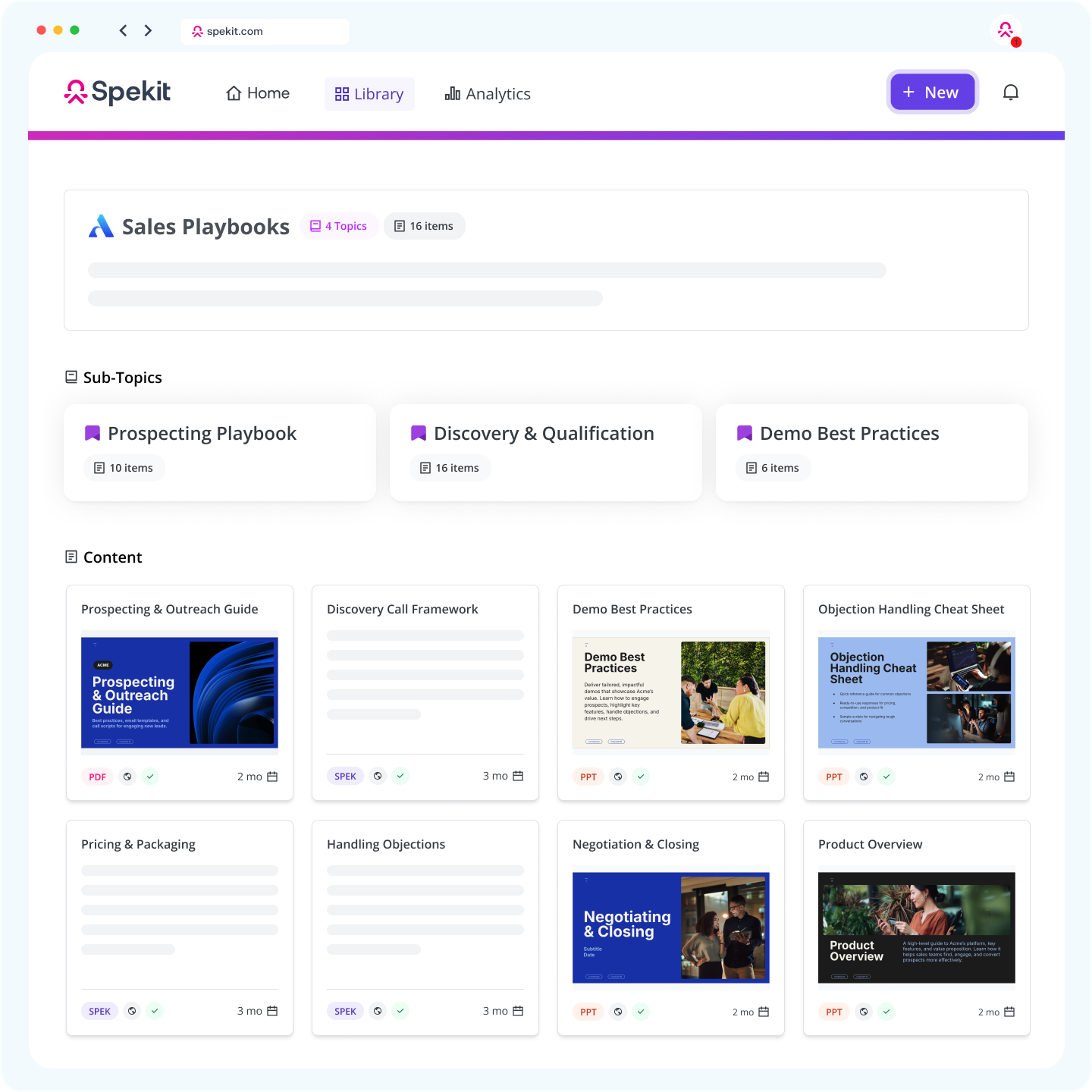
Pacvue’s accessible content hub enablement strategy example
For Pacvue, a rapidly growing adtech company, scattered content had become a serious bottleneck. Sales decks, RFP responses, and onboarding materials were scattered across countless SharePoint folders, and reps frequently turned to Slack for help finding resources. This wasted time and made reps frustrated and inefficient.
However, when Pacvue adopted şÚÁĎłÔąĎÍř, everything changed. Using ł§±č±đ°ěľ±łŮ’s content management system, they centralized all their collateral, sales decks, templates, product guides, and process documentation, into one intuitive hub. Reps could now locate any piece of content instantly without having to dig through multiple platforms.
The impact was immediate: new hires ramped faster, managers gained visibility into what content was being used, and Pacvue saved thousands of dollars in reclaimed time across their revenue teams.
2. Deliver enablement in the flow of work
Many sales reps spend hours digging through folders and Slack threads just to find the right content. And every minute spent searching is a minute spent not selling.
Delivering enablement in the flow of work changes that. Instead of pausing conversations to hunt for information, reps get the exact resources they need (talk tracks, case studies, competitive insights) right in the tools where they’re working.Ěý
This helps them respond faster, stay focused, and spend more time building relationships and closing deals.
đźÇŔ How şÚÁĎłÔąĎÍř helpsÂ
şÚÁĎłÔąĎÍř enables reps in the flow of work through AI Sidekick™, a contextual AI assistant that understands each rep’s needs by pulling context from CRM data, call intelligence platforms, and email/deal activity.
AI Sidekick then surfaces the most relevant talk tracks, case studies, and sales decks in real-time, so reps can respond confidently to prospects, handle objections smoothly, and close deals faster.

‍
Read: The AI Enablement Playbook: How modern sales teams are actually using AI to drive results
´Ü´Ç´Çłľ±ő˛Ô´Ú´Ç’s in the flow of work enablement strategy example
Before adopting şÚÁĎłÔąĎÍř, ´Ü´Ç´Çłľ±ő˛Ô´Ú´Ç’s enablement team, led by , Senior Manager of Revenue Enablement Infrastructure & Operations, was buried under process changes, communication overload, and low engagement.
Despite creating strong learning programs, information wasn’t reaching reps effectively. Newsletters had a 10% readership rate, critical updates went unseen, and enablement requests kept piling up.
Using şÚÁĎłÔąĎÍř, ZoomInfo started delivering just-in-time guidance directly inside the tools reps use every day. Instead of sending another email or chat message, sales leaders set up in-app Spotlights and tooltips within Salesforce to guide reps step-by-step through new processes as they worked.
When the team rolled out new demo call disposition rules, they used şÚÁĎłÔąĎÍř to embed learning into the CRM workflow. Within a month, over 1,100 demo calls were correctly dispositioned using the new option.
“When we calculated the impact based on average sales price, we realized we had recovered millions of dollars in pipeline,” Luke says. “And the best part? We could directly attribute it back to our enablement efforts.”
3. Make onboarding continuous (everboarding)
In her book , Melanie Fellay discusses the Forgetting Curve, a diagram developed by psychologist Hermann Ebbinghaus.Ěý

This diagram illustrates just how quickly knowledge decays without reinforcement. In fact, most information is lost within the first few hours or days after it’s learned.
“Traditional training methods like LMS courses — or even expensive events like your annual sales kickoff — often fall victim to this,” Melanie wrote. “They dump a large amount of information on learners only to have it vanish soon after because it’s never reinforced or revisited.”
This begs the question: if it can be forgotten so quickly, was it ever truly learned?Â
To make learning stick for new hires, training can’t stop after the final onboarding session. Instead, it should be reinforced in the flow of work, especially information that helps with day-to-day selling.Ěý
But don’t put that information in lengthy documents or training videos. Instead, break it down into bite-sized, actionable content and embed it directly into tools like Salesforce and Slack.
For instance, a rep preparing to move a lead to the next stage in the pipeline could see a quick tooltip reminding them to confirm qualification criteria, log key details, and attach relevant documents. Or, when responding to a prospect, they may see a brief prompt summarizing how to handle a common objection.Ěý
These in-context nudges help reps follow the right steps, apply best practices, and develop good habits, all without pausing to look things up.
đźÇŔ How şÚÁĎłÔąĎÍř helpsÂ
şÚÁĎłÔąĎÍř makes everboarding effortless with Speks — small, bite-sized pieces of content that deliver contextual, just-in-time knowledge within the apps employees already use.
When a rep encounters a relevant field, object, or keyword, a Spek icon appears. Clicking it reveals helpful definitions, process guides, videos, or other resources to help them complete the task correctly.

CoBank’s everboarding enablement strategy example
With over 1,100 employees across the United States, CoBank needed a way to guide users within the systems they used daily. Traditional user guides and Salesforce help text were limited: static, hard to maintain, and disconnected from the user’s workflow.
Using şÚÁĎłÔąĎÍř, CoBank’s content developers were able to embed Speks (bite-sized snippets of information) directly into Salesforce and nCino.
As a result, CoBank retired outdated user guides, reduced reliance on static Salesforce help text, and freed up developer time that had previously been spent answering questions or updating documentation.
4. Automate change managementÂ
Messaging evolves and processes shift all the time. Reps move so fast trying to generate deals that they miss those updates and unknowingly default to outdated information, which creates inconsistencies that ripple across the entire pipeline.
To prevent this, automate change management so reps are instantly notified whenever updates go live.Ěý

đźÇŔ How şÚÁĎłÔąĎÍř helpsÂ
şÚÁĎłÔąĎÍř automates change management with Spotlights, in-app digital alerts that deliver timely information directly within employees’ existing workflows. They can be used to onboard new hires, reinforce evolving workflows, and keep teams aligned on critical updates, all without interrupting their workflows.Ěý
With visibility into who has viewed or interacted with each alert/update, leaders get a clear picture of engagement, process adoption, and readiness across the organization.
International SOS’s automated change management enablement strategy example
With over 12,000 employees spread across 1,200 locations worldwide, International SOS faced a massive alignment challenge. Sales reps were constantly asking the same questions about tools, processes, and best practices, which clogged inboxes and slowed productivity.
To fix this, they used şÚÁĎłÔąĎÍř to deliver answers and training materials directly within their CRM, helping reps find what they need at the moment.
But one of the unexpected benefits of şÚÁĎłÔąĎÍř was how it helped drive change management.
“Whenever we rolled out a new process, there used to be a flood of questions, and we were never certain if everyone saw the message about the change,” says Alex Miller, Senior Sales Enablement Manager. “Now, we introduce the change in şÚÁĎłÔąĎÍř, push out a Spotlight (in-app) announcement, and we know the message has landed.”
The ability to track engagement was a game-changer. Sales leaders could now see who viewed updates, how long they spent on them, and who ignored them, which eliminated confusion and ensured accountability.
As a result, communication became consistent, teams adopted new processes faster, and processes were standardized across global locations.
5. Improve buyer-seller collaboration with deal roomsÂ
Using deal rooms (or digital sales rooms) is a sales enablement strategy that brings structure, transparency, and momentum to complex buying journeys.
And it's a strategy that directly combats the status quo of long email threads where sales decks, pricing sheets, competitor comparisons, and contracts are shared with multiple stakeholders. Email threads that are frustrating to navigate.
Deal rooms are centralized, branded workspaces where reps organize all deal-related content in one place.
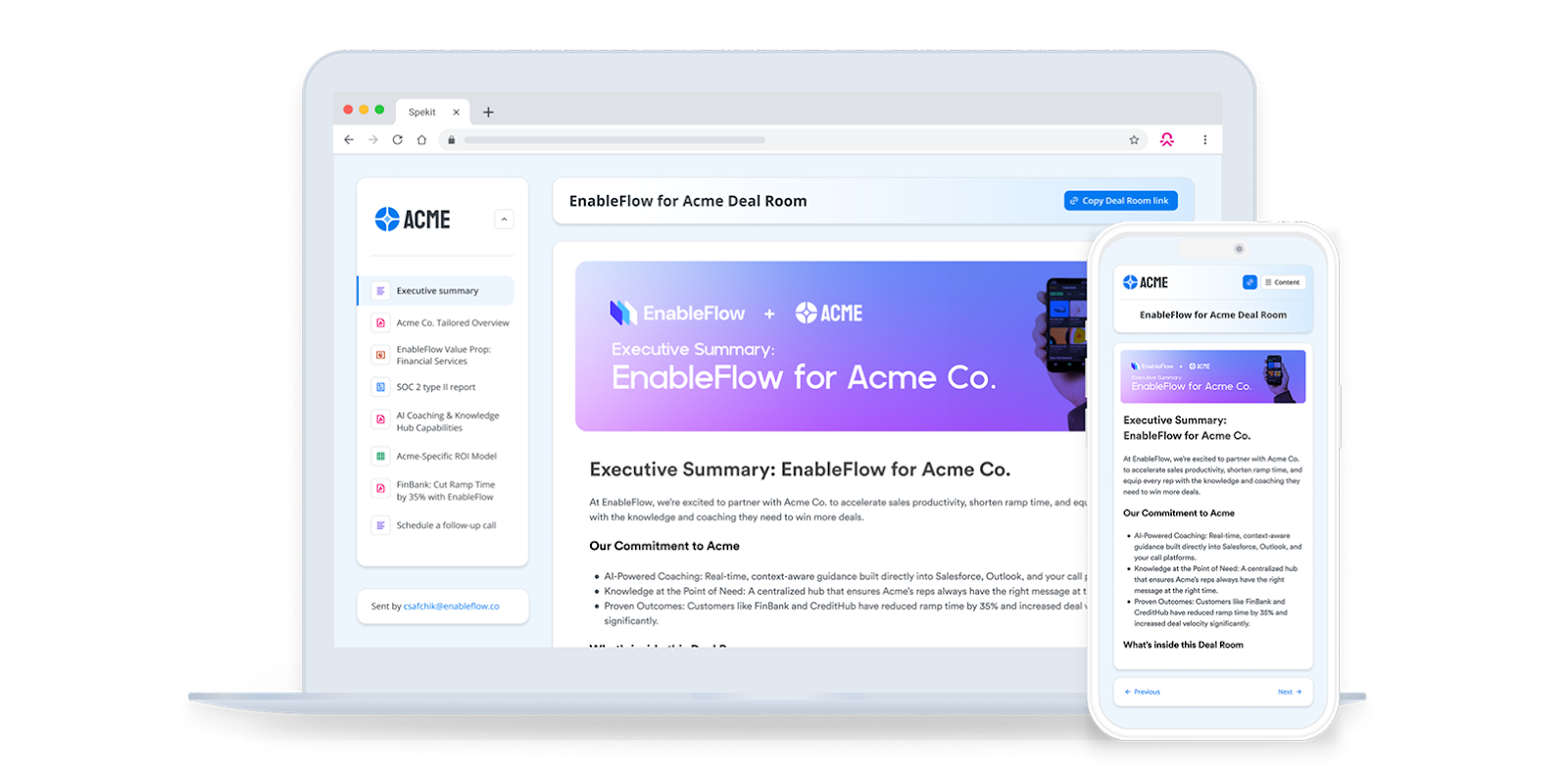
Instead of hunting through inboxes, buyers can access the latest resources instantly, and reps can ensure they’re always sharing accurate, up-to-date information.
đźÇŔ How şÚÁĎłÔąĎÍř helpsÂ
When a new opportunity opens, şÚÁĎłÔąĎÍř can automatically create a personalized Deal Room preloaded with relevant content, including proposals, case studies, contracts, and videos. As the deal progresses, AI Sidekick analyzes CRM, email, and call data to recommend the most relevant materials and messaging.
SşÚÁĎłÔąĎÍř also tracks how buyers engage (what they view, share, or spend time on) so reps can follow up with precise, timely communication.
Q4’s deal room enablement strategy example
Q4, a leading capital markets communications platform, had deal cycles that involved complex stakeholders and detailed client deliverables, so they needed a better way to organize and share sales content.Ěý
However, when , the Head of Revenue Enablement and Training, first implemented şÚÁĎłÔąĎÍř, he was skeptical. After years of using clunky legacy systems, he wasn’t expecting much. However, once the team began using şÚÁĎłÔąĎÍř Deal Rooms, that perception changed fast.
“Once I got the workflow going, I was able to create each branded Deal Room in under one minute, including custom branding... From here, we can track which sections of the Deal Room the client has viewed and for how long. This provides us with valuable data on how we can improve and consolidate the delivery of information on our end to ensure future clients are supplied with as much detail as possible and mitigate how much is missed on average.” — Mitch, Events Manager at Q4 Inc.
Within weeks, the team created hundreds of Deal Rooms. Buyer engagement soared, şÚÁĎłÔąĎÍř usage grew by 23x since the initial rollout, and there was a 30% drop in the questions managers received as reps found what they needed instantly. For Q4, şÚÁĎłÔąĎÍř Deal Rooms transformed sales collaboration into a faster, smarter, and more measurable process.Ěý
6. Evaluate knowledge retention within the workflow
In her article Making AI Part of Your Enablement Day-to-Day, Katie van Hoomissen, Senior Manager of GTM Enablement at Contentful, explored how AI can help enablement teams tailor learning and reinforce behavior change.Ěý
She emphasized that AI allows teams to move away from one-size-fits-all training and toward more contextual, personalized learning paths that adapt to each rep’s role, skill level, and deal stage.
Building on that idea, one of the most effective ways to reinforce learning is by giving reps well-timed, low-pressure quizzes/assessments at strategic moments. These quick checks help you gauge comprehension, identify knowledge gaps, and pinpoint where additional reinforcement is needed.Ěý
They also encourage reps to revisit material, which helps them remember and apply key concepts during live selling situations.

By tracking quiz results, enablement leaders can clearly see which reps are excelling, who needs more support, and how training completion correlates with sales performance.
đźÇŔ How şÚÁĎłÔąĎÍř helpsÂ
şÚÁĎłÔąĎÍř helps you measure retention through Knowledge Checks. These are short, in-app quizzes that test how well reps understand new processes, product updates, or messaging changes, and they’re delivered directly inside the tools reps use.
For example, after launching a new feature, managers can send a Knowledge Check to ascertain if reps understand what the feature does and how to position its value to prospects.
How to build a sales enablement strategy that works
You’ve just seen six real-world sales enablement strategies that reflect how top teams are enabling reps in the moments that matter. But real, repeatable impact comes when these strategies are connected under one cohesive approach — aligned to your business goals, tailored to your team’s needs, and embedded in your workflows.
Here’s a simple 5-step framework to help you build that unifying strategy and prioritize the right plays at the right time.
Step 1: Define your business goalsÂ
Before you start building, clarify what success actually looks like for your business. Sales enablement shouldn’t exist in its own bubble; it should drive measurable outcomes, such as faster onboarding, stronger pipelines, and higher revenue.
Start by asking: What problem do we want to solve right now?Â
Maybe ramp time is too long. Maybe win rates are dropping. Or maybe reps aren’t adopting new messaging. Each of these challenges targets a distinct enablement goal and a corresponding set of success metrics.
From there, tie every initiative to a business result. If onboarding is your focus, define how you’ll measure time-to-productivity and retention after 30, 60, or 90 days. If your goal is pipeline growth, track improvements in conversion rates or deal velocity after new training or tools are rolled out.Ěý
When enablement aligns with revenue and pipeline goals, it becomes a growth driver for the business.Ěý
Step 2: Map your audience and needs
Every role on your sales team has different responsibilities, challenges, and learning needs, so the training and resources should reflect that.ĚýÂ
Here’s how modern enablement typically looks across roles:
- Sales Development Representatives (SDRs): They need practical, repeatable talk tracks, objection-handling prompts, and outreach templates that help them have stronger conversations and book more meetings.
- Account Executives (AEs): Need resources such as competitive battlecards, case studies, pricing frameworks, and conversation analyses that help them master deal execution skills like discovery, negotiation, and competitive positioning.
- Sales Managers: They need data-driven visibility into rep performance and coaching opportunities. Equip them with tools and guidance for running effective pipeline reviews, tracking progress, delivering feedback, and reinforcing best practices across the team.
By mapping what each role truly needs to perform, you create enablement content that is relevant and actually gets used.
Step 3: Identify key moments to enable
Once you’ve identified your audience and their needs, pinpoint the exact moments in their workflow where they tend to slow down or lose confidence.
These moments vary by role and stage of the sales process. For instance, new hires may struggle to navigate unfamiliar tools or recall product details. AEs could stumble mid-deal when faced with a complex objection. And managers could get stuck when deciding which reps’ skill gaps to focus on during coaching.
Identifying these friction points helps you create enablement that’s timely and relevant. So, instead of overwhelming reps with information upfront, you deliver the right guidance at the right moment, helping them overcome challenges faster.
Step 4: Provide enablement in the flow of work
How you deliver enablement content determines whether reps use it or not. When information is scattered across multiple systems (e.g., LMS platforms, shared drives, internal wikis), reps lose valuable time switching between tools to find what they need. The key is to bring enablement to the rep, not make the rep go searching for it.
So, choose a sales enablement platform (like şÚÁĎłÔąĎÍř) that delivers knowledge directly in the flow of work. That looks like:
- Talk tracks and objection responses appearing within the tools reps already use, helping them recall and apply the right messaging when selling.
- Step-by-step prompts surfacing inside platforms like Salesforce or Outlook to guide reps through the selling process.
- Relevant resources like case studies, sales decks, or demo videos being recommended based on the context of the deal a rep is working on.
- Timely updates such as new messaging, product releases, or pricing changes appearing instantly in selling tools.
This approach makes enablement a part of a rep’s workflow, which saves time, reduces context-switching, and helps teams close deals faster.Ěý
Step 5: Build a feedback and measurement loop
No enablement strategy is complete without a way to measure its impact. You’ll want to know what’s working, what’s not, and where to improve next.
Start with qualitative feedback. Run short, anonymous surveys after implementing your strategy to capture reps’ honest perspectives. Ask questions like:Â
- Was this content helpful?Â
- Did it show up when you needed it?Â
- What would’ve made it more useful?Â
Anonymous input removes pressure and helps reps share genuine insights about how enablement feels in their day-to-day work.
Then, layer in quantitative data. Track key metrics that show whether enablement is driving meaningful performance improvements. Examples include:
- Onboarding time: How long it takes new hires to reach full productivity.
- Content engagement: Which resources are being viewed, shared, or ignored?
- Quota attainment: How training or new messaging impacts win rates and revenue.
- Activity completion: Whether reps are following updated processes or workflows.
- Sales cycle length: How quickly deals move from discovery to close after new training is introduced.
- Time-to-first deal: How quickly new reps close their first deal after onboarding.
Finally, bring these signals together into a continuous improvement loop. For instance, if surveys reveal confusion around a new playbook and engagement data confirms low usage, that’s your cue to simplify or reposition the material.Ěý
Read: How to measure sales productivity
The tools powering the best sales enablement strategies
To bring your strategy to life, you’ll need the right mix of tools, each designed to tackle a specific function. Here are some sales enablement software top-performing teams use to train smarter and sell faster:
şÚÁĎłÔąĎÍř — For a unified content hub with in-workflow enablement

şÚÁĎłÔąĎÍř is a modern sales enablement platform that unifies the best of digital adoption (DAP), knowledge management (KMS), content management (CMS), and learning management (LMS) features into one seamless experience.Ěý
Instead of forcing reps to leave their sales tools to search for answers, it delivers bite-sized knowledge, content, and guidance directly inside the tools they use every day, helping them learn and act faster.
Key features of şÚÁĎłÔąĎÍř:
- AI Sidekick: An AI-powered assistant that lives in the rep’s workflow, providing instant answers, content suggestions, and tailored messaging support.
- Microlearning (Speks): Bite-sized tooltips that embed training and process guidance directly inside CRMs, email, and communication tools.
- Content management: A centralized hub for playbooks, battlecards, and training docs, with AI that organizes, summarizes, and flags duplicate content.
- Deal rooms: Branded, trackable digital spaces where reps and buyers can share decks, pricing docs, and contracts for smooth collaboration.
- Spotlights: In-app alerts that instantly notify reps about new resources, product updates, or process changes.
- Knowledge checks: Short, in-app quizzes that reinforce learning and reveal areas where additional coaching is needed.
- Analytics and insights: Dashboards that track content usage, buyer engagement, and enablement impact across the team.
Gong - For capturing and analyzing customer conversations
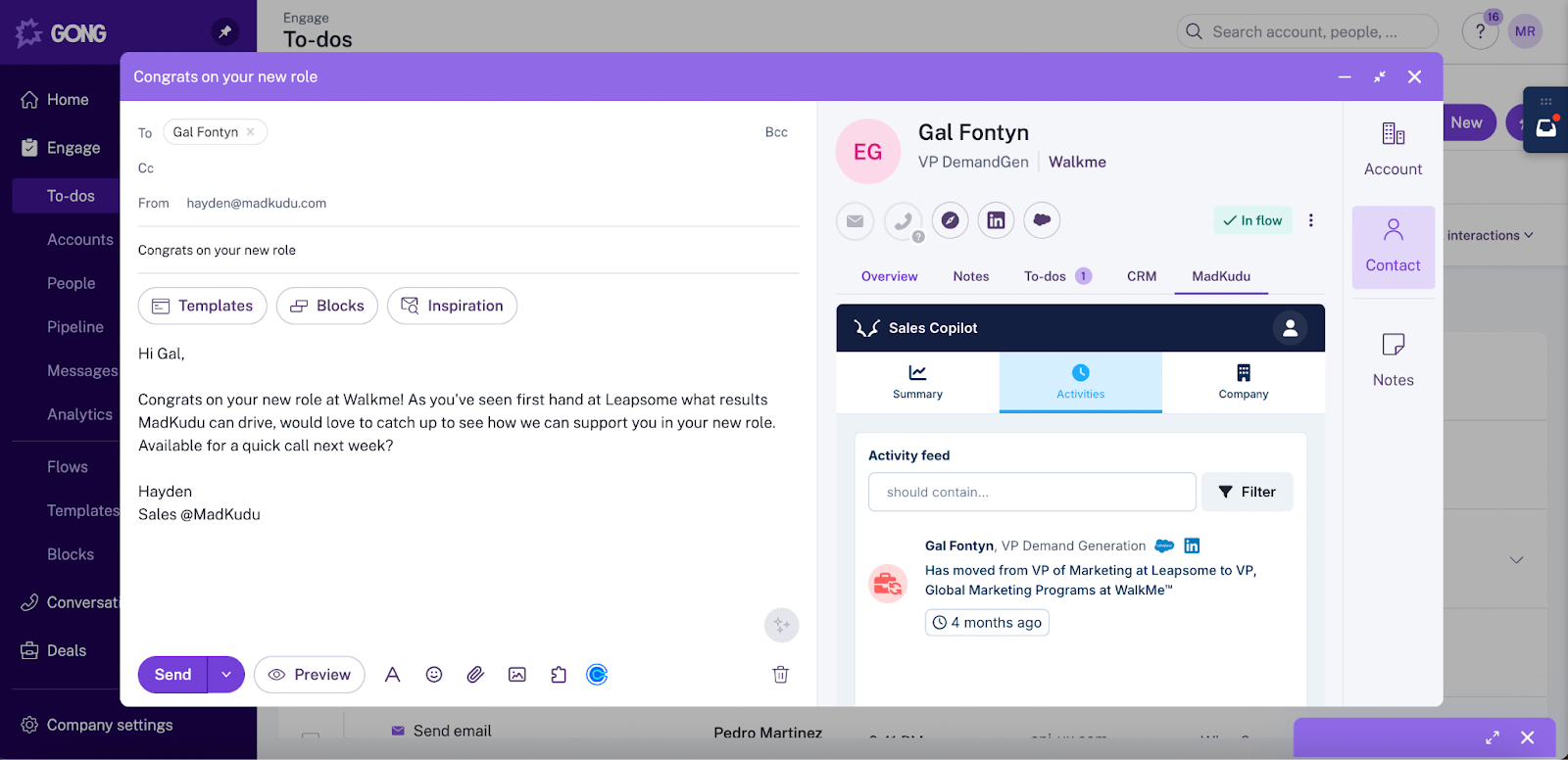
Gong is a revenue intelligence platform that captures and analyzes calls, emails, and meetings to show leaders what’s really happening in deals. With AI-driven insights into rep behavior and buyer engagement, enablement teams can identify skill gaps, tailor coaching to each rep, and replicate top-performer behavior across the sales team.
Key features of Gong:
- Conversation intelligence: Records, transcribes, and analyzes every customer interaction to surface key topics, competitor mentions, and sentiment trends.
- Deal intelligence: Connects conversation data with CRM activity to determine deal health and flag at-risk opportunities.
- Sales coaching: Highlights top-performer behaviors, identifies skill gaps, and provides a library of standout calls to support data-driven coaching..
- Forecasting: Uses AI to predict deal outcomes from real interactions, flag risks early, and deliver accurate pipeline visibility.
- Sales engagement: Automates follow-ups and prioritizes outreach based on customer activity, helping reps focus on actions that drive deals forward.
WorkRamp - For building large-scale enablement programs
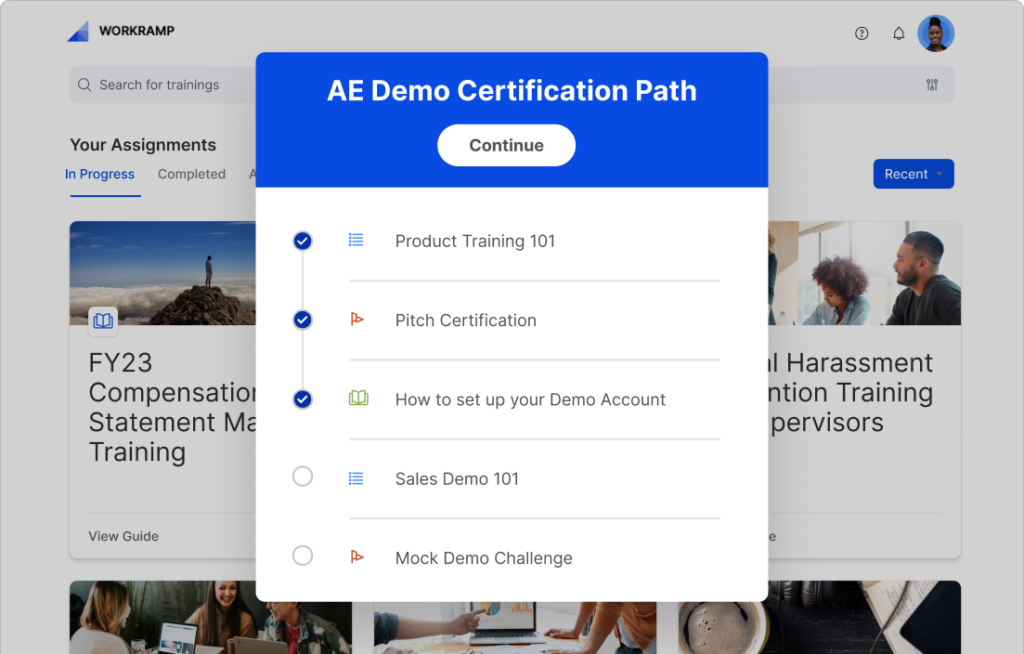
WorkRamp is an AI-first Learning Management System (LMS) companies use to create, manage, and deliver long-form training for employees, customers, and partners.Ěý
This platform helps sales leaders create customized and interactive courses that helps reps ramp quickly and improve their skills.
Key features of WorkRamp:Â
- AI-powered learning: Uses AI to generate courses and quizzes from existing content while personalizing learning paths by role, territory, or experience level.
- Built-in course authoring: Offers a drag-and-drop editor that lets sales leaders quickly build interactive courses with videos, quizzes, and text.
- Certifications and assessments: Delivers role-based certifications and quizzes to validate sales readiness, measure retention, and pinpoint skill gaps.
- Analytics and reporting: Provides customizable dashboards that track key learning metrics.Ěý
Second Nature - For practicing sales conversationsÂ
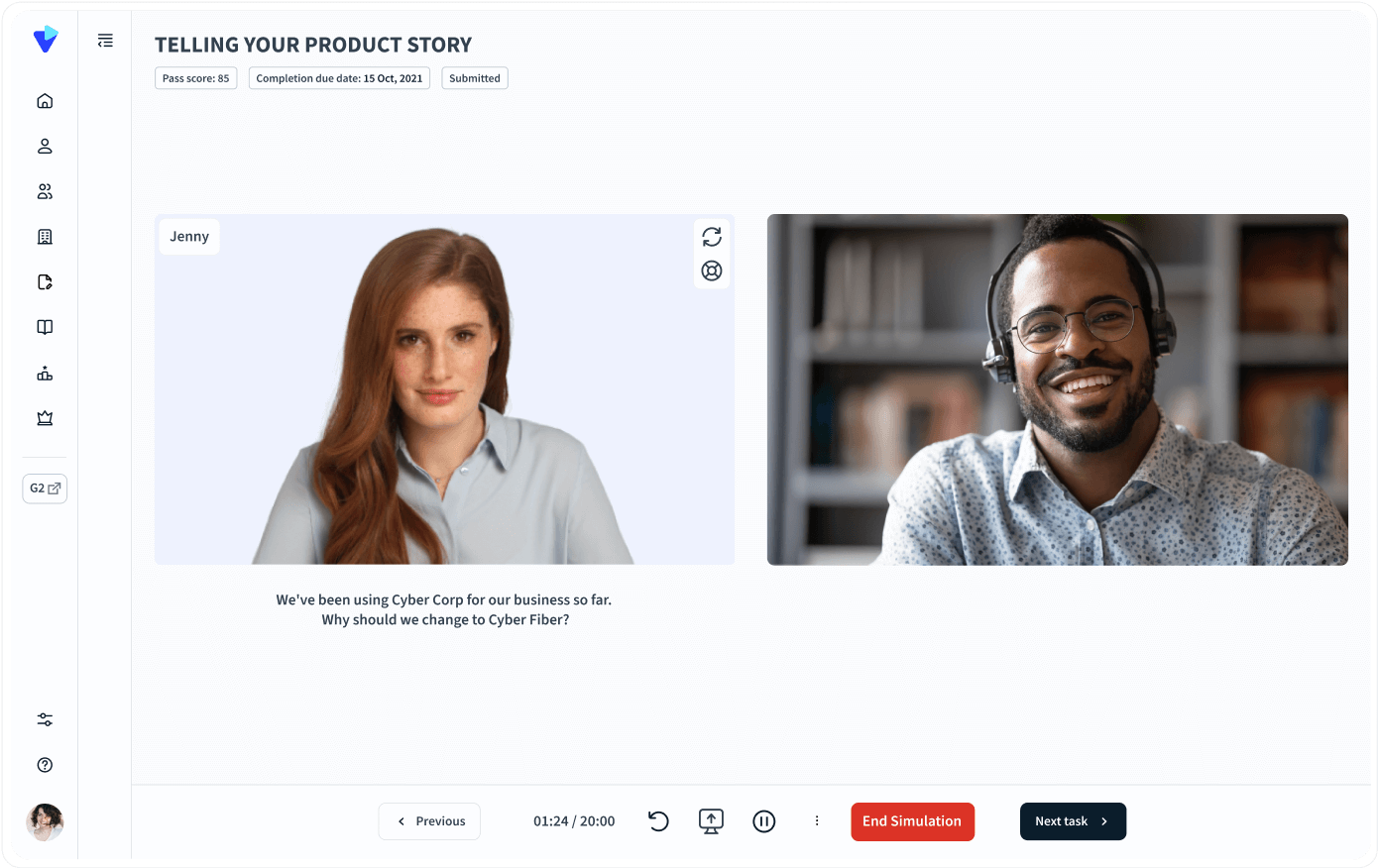
Second Nature is an AI-powered sales coaching platform that uses conversational AI to simulate real buyer interactions. Reps can practice pitches, objection handling, and discovery calls with lifelike virtual customers, and get instant feedback in a low-pressure environment.Ěý
It’s a safe, repeatable way for reps to refine their communication skills and build confidence before having real conversations.
Key features of Second Nature
- AI-powered virtual role-play: Lets reps hold realistic conversations with AI-driven virtual customers to practice selling skills safely and effectively.
- Real-time feedback: Provides instant insights on tone, pace, word choice, and overall delivery to help reps improve their performance.
- Customizable training programs: Allows leaders to design training modules and role-play scenarios tailored to specific goals, products, or objections.
- Performance analytics and reporting: Delivers dashboards that track progress, reveal strengths and weaknesses, and measure skill growth over time.
- Skill gap analysis: Identifies individual skill gaps from AI simulations and recommends personalized coaching plans to address them.
Read: 16 Best Sales Productivity Tools in 2025
Reimagining sales enablement with şÚÁĎłÔąĎÍř
Modern sales enablement focuses on integrating knowledge directly into the daily rhythm of selling, so reps can learn, adapt, and perform without breaking stride. The best strategies give sales a single source of truth, surface the right content at the right time, reinforce key concepts, and give leaders visibility into what’s actually driving sales.Ěý
şÚÁĎłÔąĎÍř brings all of this together in one platform. It combines AI-powered content management, collaborative deal rooms, bite-sized microlearning, built-in Knowledge Checks, and more to help teams learn, act, and adapt in real-time.
If you’re ready to move beyond outdated enablement stacks and transform how your team learns and sells, book a demo with şÚÁĎłÔąĎÍř.Ěý

